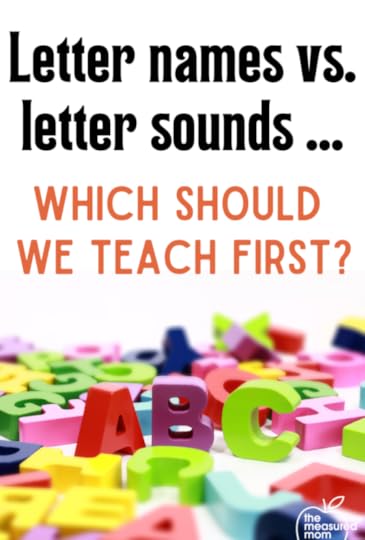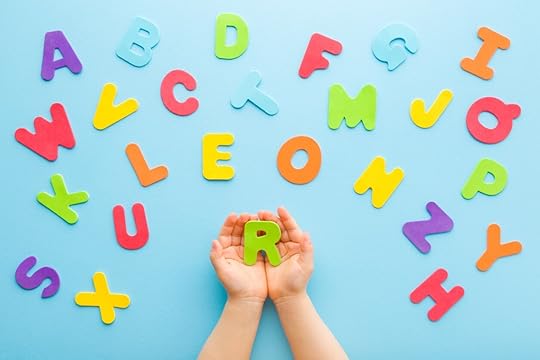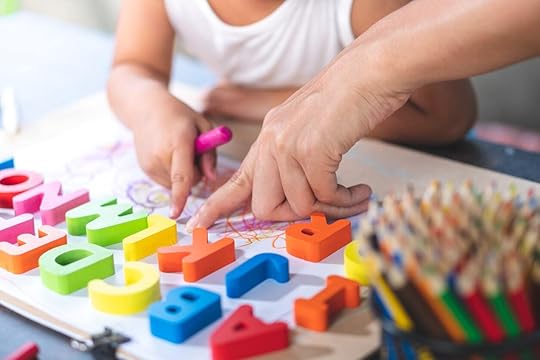Should we teach letter names or letter sounds first?
If you ask this question in a Facebook group, watch out. People on both sides of the aisle have strong opinions, and many of them will tell you that their opinions are absolutely backed by research.
At a recent Reading League event, Dr. Steven Dykstra joked that people on both sides of this debate will start pulling punches if you put them in the same room!
(I think he was only sort of joking.)
So ��� who���s right? Should we teach letters or sounds first?

Let���s start by looking at the arguments for each side of the debate.
Why you might teach letter names firstLearning letter names helps students remember letter sounds, because many letters��� sounds are embedded in the letter name itself.Letter names are the only stable property of a letter. The shape changes depending on upper or lower case and the use of different fonts. The sound changes when letters can represent more than one sound. But the name of the letter never changes. Why you might teach letter sounds firstWhen it comes to sounding out a word, the letter sounds (not names) are what���s important.
Some children may be confused when learning both and mix up letter names with their sounds.
Children with poor working memory may struggle to remember both letter names and sounds.
The fact is, despite claims you may hear to the contrary, there isn���t a lot of clarifying research on this topic. However, there is growing evidence that children do well learning both letter names and sounds at the same time.
Before we draw conclusions, however, we need to tackle an important question.
 Why teach letter names at all?
Why teach letter names at all?This is a fair question, because, strictly speaking, you would not need to know letter names to read.
REASON #1A big reason to teach letter names is that ���preschoolers��� knowledge of the names of printed letters has long been known to be among the strongest predictors of success in learning to read��� (Share, 2004, p. 214).
Some will say this is simply correlational, that children who know the alphabet in preschool have a strong literacy environment prior to coming to school, so it makes sense that they will be more successful as readers.
However ��� Share and his colleagues (1983) found that letter name knowledge has a greater effect on reading success than other variables, such as socioeconomic status or even how much parents read to their children.
Exactly why knowing letter names is a good predictor of reading success is still up for debate. (But if you want some possible reasons, check out the 2004 Share article linked below.)
REASON #2Another reason to teach letter names is that research clearly shows that learning letter names helps students retain letter sounds when the letter name contains its sound (as in the sound /b/ and the letter B) (Share, 2004).
REASON #3Yet another reason to teach letter names is because they are important labels for letters. Using a letter���s sound as its label – /s/ instead of S, for example, will quickly become confusing because many letters represent multiple sounds, especially when used in combination with other letters (as in sh, for example).
So … what’s the answer? Letter names or sounds first?Based on the reading I���ve read and the research I���ve studied, my conclusion is that we should teach letters and sounds concurrently, beginning in preschool.

However, just to be clear: I don���t believe that teaching letter names (without also teaching sounds) has to be a problem when we are teaching very young learners. After all, many children come to preschool knowing at least a few letter names because of the efforts of well-meaning parents. We shouldn���t fight or lament this. When students come to us in the classroom, we can use the letter-name knowledge to our advantage as we use that knowledge to help them learn letter sounds (particularly those that are connected to the letter name).
Let me state my position again: Once children are in preschool, I believe that the best approach to teaching the alphabet is to teach letter name, sound, and letter formation at the same time.
What should this instruction look like?Stay tuned! This is just the first in our series about teaching the alphabet.
Articles to read Foulin, J.N. (2005) Why is letter-name knowledge such a good predictor of learning to read? Reading and Writing 18:129-155.Piasta, S.B. & Wagner, R.K. (2010). Developing early literacy skills: A meta-analysis of alphabet learning and instruction. Reading Research Quarterly 45(1), 8-38.Piasta, S. B., Purpura, D.J. & Wagner, R.K. Fostering alphabet knowledge development: A comparison of two instructional approaches. Reading and Writing 23:607-626.Share, David L. (2004). Knowing letter names and learning letter sounds: A causal connection. J. Experimental Child Psychology 88 (224), 213-233. Treiman, R., Sotak, Lia, & Bowman, M. (2001). The roles of letter names and letter sounds in connecting print and speech. Memory & Cognition 29 (6), 860-873.Share, D.L., Jorm, A. F., Maclean, R., Matthews, R., & Waterman, B. (1983). Early reading achievement, oral language ability, and a child’s home background. Australian Psychologist, 18, 75-89.Helpful video to watchPromising New Evidence for Improving Alphabet Instruction with Robert Meyer
The post appeared first on The Measured Mom.
Anna Geiger's Blog
- Anna Geiger's profile
- 1 follower



